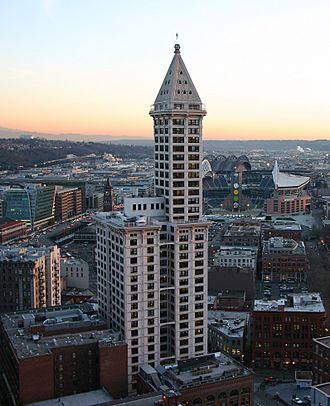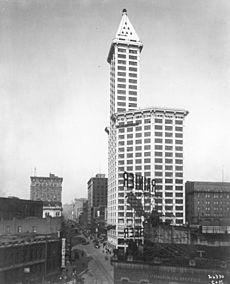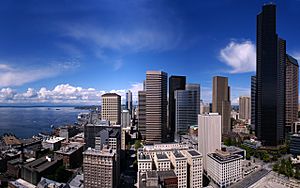Smith Tower facts for kids
Quick facts for kids Smith Tower |
|
|---|---|

Smith Tower as seen from the Pacific Building.
|
|
| Alternative names | L.C. Smith Building (1914–1929) |
| Record height | |
| Tallest in Seattle and Washington from 1914 to 1962 | |
| Preceded by | Hoge Building (Seattle) Key Bank Center (Tacoma/statewide) |
| Surpassed by | Space Needle |
| General information | |
| Type | Commercial offices Residential |
| Location | 500 Second Avenue Seattle, Washington, U.S. |
| Coordinates | 47°36′08″N 122°19′54″W / 47.602092°N 122.331803°W |
| Construction started | 1911 |
| Completed | 1914 |
| Cost | US$1.5 million |
| Owner | Unico Properties |
| Height | |
| Antenna spire | 484 ft (148 m) |
| Roof | 462 ft (141 m) |
| Technical details | |
| Floor count | 38 |
| Floor area | 28,275 m2 (304,350 sq ft) |
| Lifts/elevators | 7 |
| Design and construction | |
| Architect | Gaggin & Gaggin |
| Main contractor | E.E. Davis Company |
| Designated: | June 12, 1984 |
The Smith Tower is a super tall building, called a skyscraper, located in the Pioneer Square area of Seattle, Washington, United States. It was finished in 1914. This 38-story tower, standing 462 ft (141 m) tall, was one of the tallest skyscrapers outside New York City when it was built.
For many years, it was the tallest building west of the Mississippi River. It held this title until 1931 when the Kansas City Power & Light Building was completed. The Smith Tower also remained the tallest building on the U.S. West Coast for almost 50 years, until the famous Space Needle was built in 1962.
The tower is named after its builder, Lyman Cornelius Smith. He was a very successful businessman who made firearms and typewriters. His son, Burns Lyman Smith, mostly managed the building's construction after his father passed away in 1910. The Smith family owned the tower until the 1940s. It was first known as the L.C. Smith Building, but its official name became Smith Tower in 1929. In 1984, it was recognized as a Seattle landmark, which means it's an important historical building.
Contents
Building the Smith Tower: A Look Back
How the Smith Tower Idea Began
After the exciting Klondike Gold Rush, many wealthy people from the East Coast became interested in investing in Seattle. A lawyer named James Clise helped many rich investors buy land in the city. One of his biggest clients was Lyman Cornelius Smith, a millionaire from New York. He and his brother bought and developed many buildings in Seattle's Pioneer Square area.
L.C. Smith became the city's biggest taxpayer and owned more real estate in Seattle than anyone else. He bought a unique piece of land in 1899. At first, he planned a 14-story building. However, his son, Burns Lyman Smith, convinced him to build an even taller skyscraper. They wanted it to be taller than Tacoma's National Realty Building, which was then the tallest west of the Mississippi River.
Smith chose architects Gaggin and Gaggin from Syracuse, New York. In 1910, they announced plans for a 26-story building. Later, Smith even considered building a 40-story tower if Seattle's city hall stayed in its current location. This would have made the Smith Tower the third tallest office building in the world!
Designing a Giant Skyscraper
As L.C. Smith's health declined, his son Burns and architect Edwin H. Gaggin took charge. They finalized plans for a 467-foot (142 m), 42-story building. It would have a strong steel frame and concrete structure. The bottom floors would be covered in granite, and the rest in shiny white terra cotta. People said the building would "cast the rays of the sun in a blaze that should be seen 15 or 20 miles."
The tower was designed with eight fast elevators to carry many passengers each day. It also had a heating system and a water cooler. A huge 12,000-gallon water tank was planned for the pyramid roof. L.C. Smith passed away in November 1910, before construction even began.
Starting Construction and Overcoming Challenges
Getting approval for such a tall building was tricky because it was much taller than existing city rules allowed. After many reviews and talks, the final building permit was issued in February 1911. With L.C. Smith's estate settled, bids for construction were opened in May 1911. Over 160 companies wanted to help build it!
On September 5, 1911, the first contracts were signed. The Whitney-Steen Company from New York was chosen for general construction. They hired the American Bridge Company to provide nearly 5,000 tons of steel. Local companies also helped with tiling, plumbing, electrical wiring, and bricks. Construction officially began on November 1, 1911.
Building Up: From Foundation to Finish
Workers dug a 25-foot (7.6 m) deep foundation day and night. Engineers carefully tested the ground to make sure it could support the massive building. L.C. Smith's son, Burns, and architect Gaggin came to Seattle in January 1912 to oversee the first floors. They even used a large oil painting of the building for advertising across the country.
By July 1912, the first steel for the tower's frame arrived. The foundation was complete by August, and the steel frame quickly began to rise. The building's steel frame was finished very fast, with the last rivet driven on the 42nd floor on February 15, 1913. A photographer even climbed the building, which still didn't have stairs above the 16th floor, to capture the moment!
One big event during construction was when a 70-foot (21 m) wooden crane fell from the 34th floor. It crashed through 13 floors, but amazingly, no one was hurt! Construction continued without delay. Concrete work and fireproofing were done in the summer, and the shining terracotta outside began to cover the steel frame.
Grand Opening and the Wishing Chair
The Smith Tower was completed in 1914, reaching 143 m (469 ft) to the top of its pyramid. It opened to the public on July 4, 1914. On opening day, over 4,000 people rode the elevators to the 35th floor!
The building had a special room called the Chinese Room. It had a beautiful carved teak ceiling and blackwood furniture. This furniture was given by the last Empress of China, Cixi. The room also featured the famous Wishing Chair. This chair had carvings of a dragon and a phoenix, which together symbolize marriage. Legend says that any unmarried person who sat in it would get married within a year. This legend even came true for Smith's own daughter, who got married in the Chinese Room!
Smith Tower Through the Years
Changes in Ownership and Updates
Over the years, the Smith Tower has had several owners. In 1976, Ivar Haglund, famous for his Seattle restaurants, bought the tower for $1.8 million. The building was updated twice, in 1986 and 1999.
In 2006, Walton Street Capital bought the building. However, after the "dot-com bubble" burst, many companies left, and the building had many empty offices. By 2007, things improved, and the building was almost full again, with new tenants like Microsoft Live Labs.
In 2011, the building faced financial trouble. It was eventually sold at an auction in 2012 to CBRE Group. After this, new companies started moving into the empty floors, bringing new life to the tower.
Modern Renovations and Visitor Experience
In January 2015, a Seattle company called Unico Properties bought the Smith Tower for $73.7 million. They started remodeling the public areas, including the Chinese Room, which had been closed. A new restaurant with a "speakeasy" theme (like a secret bar from the 1920s) was built on the observatory floor. Some of the original Chinese Room decorations, like the Wishing Chair and carved ceilings, were used in this new restaurant.
A new self-guided tour for visitors started on August 25, 2016. It included new exhibits and the opening of the observation floor bar. The tour ticket cost $19.14, a nod to the building's opening year. In October 2018, the building was sold to Goldman Sachs. Most recently, in August 2024, GT Capital and other investment firms bought the Smith Tower.
What Makes Smith Tower Special?
The Smith Tower is a great example of neoclassical architecture, a style that uses ideas from ancient Greek and Roman buildings. The outside of the building has granite on the first two floors and terracotta on the rest. The exterior has only been cleaned once, back in 1976!
The building was one of the last on the West Coast to have elevator operators. These operators would manually control the elevators. The elevators, made by the Otis Elevator Company, had shiny brass surfaces. The original doors were like open gates, letting riders see into each hallway. In 2017, the elevators were updated to be automatic and safer, but they still have new glass doors that let you see out.
After a renovation in the early 1990s, a huge 10,000-US-gallon (38,000 L) water tank at the top of the tower was removed. This space, along with a former maintenance worker's apartment, was turned into a three-story penthouse. It's the only home in the entire building! In 2010, a family of four lived there.
The very top of the building has an 8-foot (2.4 m)-wide glass dome. It glows with blue light, except during December when it changes to green.
See also
 In Spanish: Smith Tower para niños
In Spanish: Smith Tower para niños
- Smith Tower Annex




